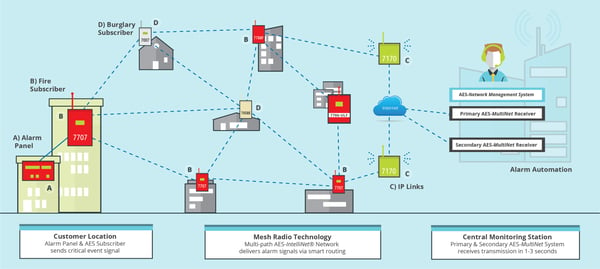Please note, this blog post is offered for reference only to be used as a general guideline for
networks utilizing the 7705i MultiNet Receiver (similar guidelines are being developed for next generation 7705ii MultiNet Receiver networks). Not all networks are the same, each private network has a different set of variables and unique configuration. Field Technicians and Installers should always seek appropriate advice from a member of the AES Support team if they have a question or need assistance.
Based on Our Experience
The capacity of Subscribers supported by a set of IP Links or Hybrid Subscribers when establishing a network will be up to 1,200 Subscribers. Actual capacity may be higher or lower depending on geography, environmental factors, deployment strategies (frequency of Check-Ins, Time-to-Live settings, etc.), and quality of installations.
Factors that Impact Network Performance
The list below provides examples of the more common environmental, geographic, and programmatic factors which may affect network performance and overall capacity:
- Drastic elevation changes in the topography or terrain – both natural and man-made
- Urban areas v. suburban or rural areas
- Density of subscribers
- Subscriber deployments over a large geographic area - can require additional IP Link(s)
- Frequency of Check-In’s
- Packet TTL settings
- # of Events being reported within a given time period
Maximum Network Size Recommendations
- Subscribers per MultiNet Receiver: Up to 9,000
- Business Units per MultiNet Receiver: Up to 15 (maximum)
- IP Links (or Hybrids) per MultiNet Receiver: Driven by network need
(do not exceed 9,000 Subscribers or 25 IP Links) - Subscribers per IP Link: Up to 1,200 (based on factors referenced above)
For networks that exceed the above recommendations, AES suggests implementing a multi-frequency or multi-receiver strategy whereby the network is segmented into smaller subnets.
Antenna Selection
Antenna selection is also an important aspect of network performance. Always use the lowest gain antenna possible to achieve a good signal. Using a higher gain antenna will cause overreach of the Radio Frequency signal. The following are effective distance potentials in an ideal RF environment for the various antennas available from AES (these are distance estimations only; actual performance will be affected by installation quality, cable length, and other environmental factors):
- Rubber Duck - up to 3 miles
- Stealth - up to 3 miles
- 3dB - up to 3 miles
- 5dB - up to 5 miles
- 6dB - up to 10 miles
- 9dB - up to 15 miles
Time to Live (TTL)
How to properly program and set packet ‘Time To Live’ (TTL) function is a topic we are
frequently asked about. In most cases, the default settings will be appropriate. You may
never have to use it, but in the event a condition arises causing congestion to occur you’ll
be glad to have the TTL functionality in place to help manage communication and maintain
normal status. We strongly suggest you check to see if you have the latest firmware version
release installed and use the current suggested settings for all and new default TTL values.
This can help free up airwaves for critical packets:
- Check-In, Status, and Special are set to ‘10 minutes’
- Alarm, Trouble, Restoral, and IntelliTap are set to ‘3 hours’
For full Solution and detailed instructions, please visit the Dealer Portal. If you need
further assistance with access to the portal or wish to schedule an upgrade, contact our
AES Support team by starting a live chat session (click on the ‘Support Online’ button on our
aes-corp.com website).
Preventative Maintenance
AES also recommends the implementation of a comprehensive preventative maintenance program to ensure optimal network health. The following link is to the AES recommended preventative maintenance plan: http://insights.aes-corp.com/blog/preventative-maintenance
Battery Monitoring
Regular monitoring of your batteries can help avoid potential issues like Subscribers locking
up, overheating, or causing communication failures resulting in ACK Delays. A few key
things to remember:
- Bad batteries that are old and/or battery cable terminals that are corroded need
to be cut and replaced before another new or used battery can be attached - Batteries need to be tested on a regular basis
- Observing DVM readings (attach red lead to red terminal and black lead to
black terminal) and writing the date of install on the batteries (like you
would for an oil change on your car) can help you monitor how long a battery
has been in service
Repair due to burnt overheated components because of bad batteries.
Repairs
When components of your AES network require repair, those repairs should only be performed by a qualified AES trained technician. Failure to do so may void your product’s warranty. Regardless of your product’s warranty status, any repairs should be performed by an AES trained technician. There are many aspects of AES products that need to be considered during the repair cycle to ensure compatibility. Contributing factors include hardware version, firmware version, chipset, and others. AES Technical Support can assist in determining interoperability between components.
Stay Up To Date
As with any technology, improvements are implemented throughout a product’s lifecycle. Improvements are made towards improved efficiency, reliability, and overall performance. Technologists encourage organizations to develop and implement comprehensive technology refresh strategies to ensure their investments are protected. Similarly, AES recommends that our customers implement technology refresh plans specific to their AES-IntelliNet and IntelliNet 2.0 networks. The most diligently executed maintenance plan will not prevent obsolesce or mechanical failures associated with prolonged use. As such, our customers should plan to refresh their various AES network components accordingly. Customer should inspect each component annually to verify proper operational performance and visually inspect the component’s physical condition. Please refer to the Discontinued Products list posted on our aes-corp.com website under the Products & Services tab on the main menu bar.
The table below provides basic refresh guidance:
| Network Component | Refresh Frequency |
| Subscriber |
Every 7 to 10 years based on operational environment |
| IP Link | Every 7 to 10 years based on operational environment |
| MultiNet Receiver | Every 7 to 10 years based on operational environment |
| Antennas | Every 1 to 3 years for outdoor, will vary based on exposure and climate Every 5 to 7 years for indoor |
| Coaxial Cable |
As necessary based on physical and operational inspections |
Need technical assistance with your install?
Our team is here for your team! Start a live chat session with one of our alarm industry experts.
Ask us about our Professional Services for help with network planning, site certification, review and guidance related to network management issues, Central Station moves and changes, etc.
aes-corp.com | dealer login | (866) 237-3693 | support@aes-corp.com







